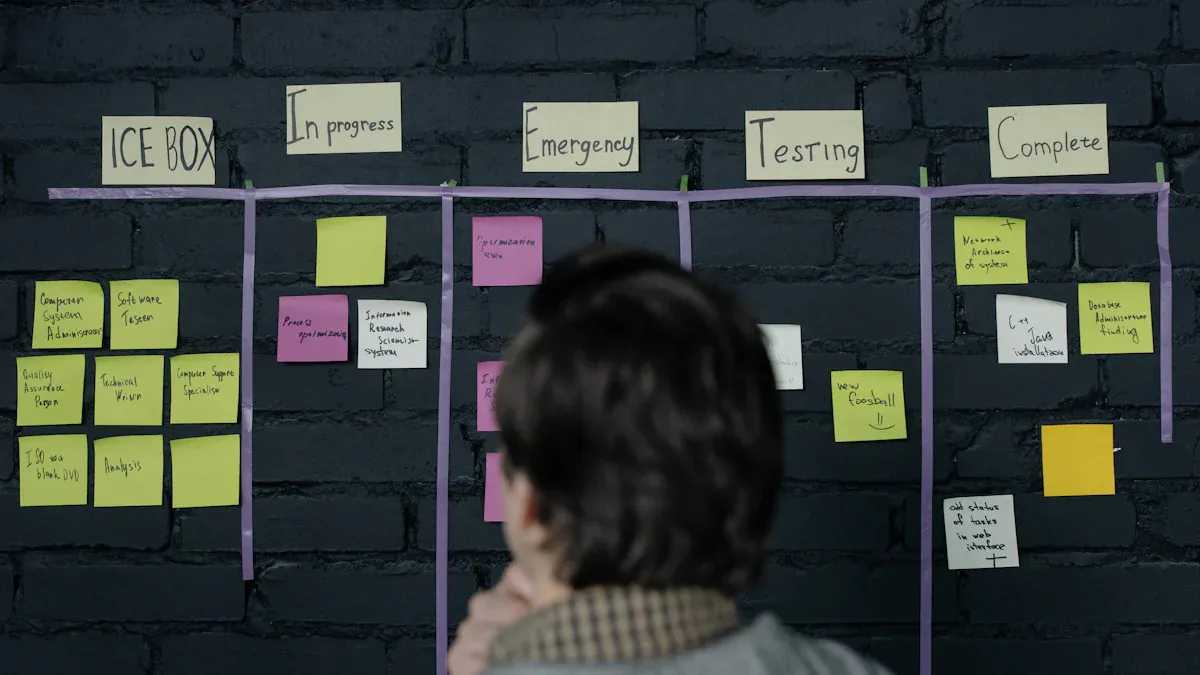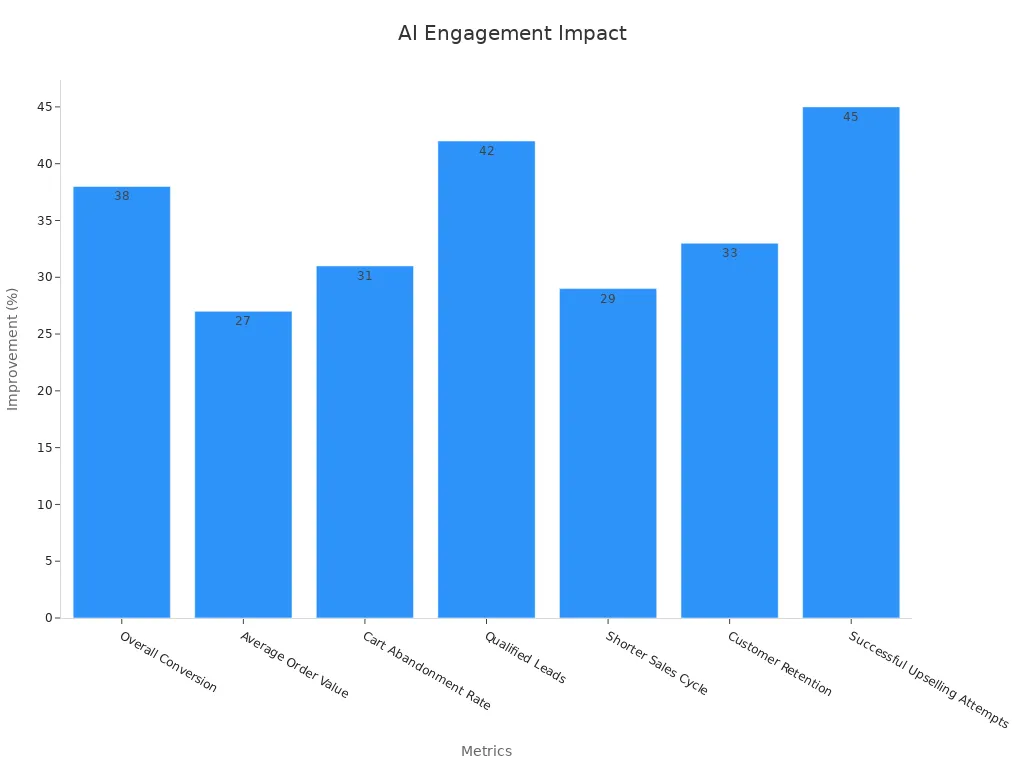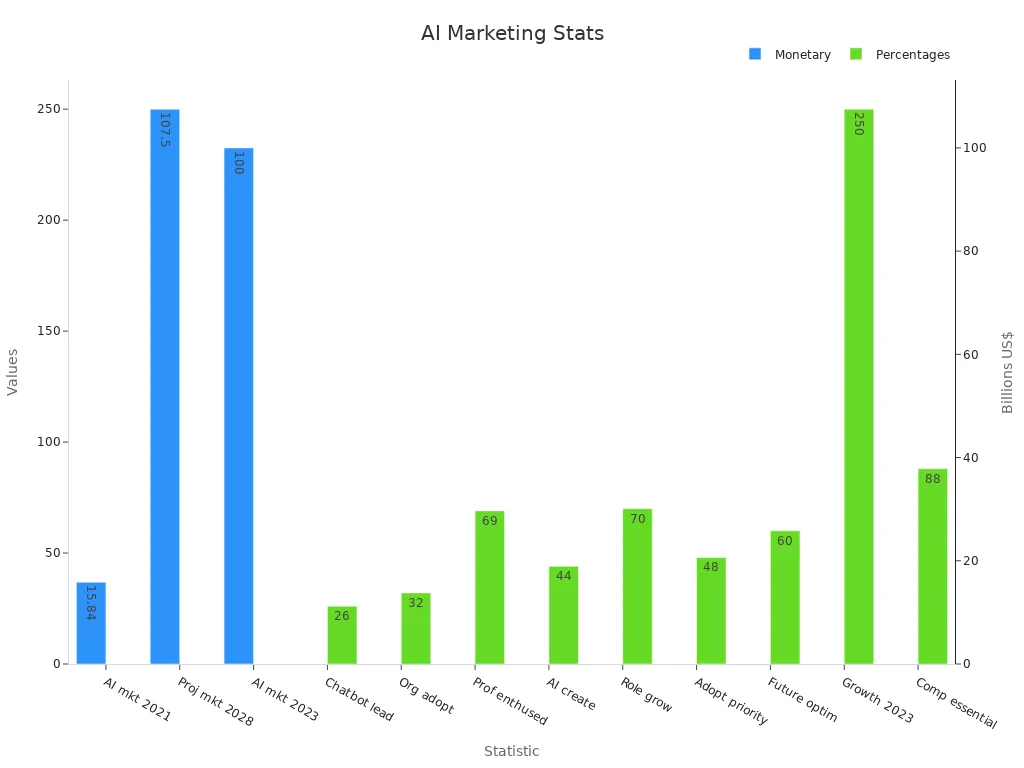The Benefits of AI in Agile Marketing

In today’s fast-changing business world, agile marketing is key. It focuses on being flexible and quick to adapt. Did you know 98% of companies using Agile succeed? Also, 93% of marketing leaders say Agile speeds up work. This is where the benefits of AI come into play. AI looks at real-time data to find trends fast. It lets you change plans quickly and stay ahead. This helps you beat competitors and lower risks. AI also finds hidden chances and helps you decide smarter. It gives your marketing a big advantage.
Key Takeaways
Agile marketing is important for success, with most companies seeing good results.
AI looks at live data fast, helping marketers decide quicker and smarter.
Using AI for boring tasks saves time for creative ideas.
AI tools test and track campaigns better, boosting results and profits.
AI makes messages personal, making customers feel special and buy more.
AI helps teams work together by sharing ideas and data for better choices.
AI predicts trends and warns about risks before they happen.
Starting with small AI tasks makes it easier to use and get benefits.
Benefits of AI in Better Decision-Making
Insights from Data
Real-time data helps make quicker, smarter choices.
Think about deciding fast with real-time facts. That’s what AI does. It reviews huge amounts of data in seconds. This gives you answers that would take people days to find. For instance, AI can study customer reviews, sales patterns, and social media posts. This helps you stay ahead of others. In Australia, Bayer used AI to predict flu seasons. They ran special ads, increasing clicks by 85% and doubling website visits. With AI, you don’t just follow trends—you predict them.
AI turns big data into useful ideas.
AI doesn’t just look at data; it makes it useful. It checks different types of data from many sources. This keeps the information correct and clear. Tools like YouScan find trends and what people like. This helps you plan better using facts, not guesses. Sephora used AI to make customers happier, raising online sales by 30%. AI helps you find hidden chances and make faster, smarter choices.
Improving Campaigns
AI helps test and track campaigns easily.
Testing campaign ideas can take a lot of time. AI makes it faster by automating A/B testing. It shows which idea works best. AI also watches campaign results live, so you can adjust quickly. Coca-Cola uses AI to test ads and improve audience interest. This keeps campaigns working well and boosts your profits.
Tools that make marketing better.
AI tools are changing how campaigns work. Netflix uses AI to suggest shows, keeping viewers interested. HubSpot uses AI to rank leads based on activity. These tools save time and get results. Euroflorist used AI to improve their website, raising sales by 4.3% in three months. Adding AI to your marketing can bring great results too.
Benefits of AI in Automated Task Management

Simplifying Repetitive Tasks
Automating emails, social media posts, and reports.
Doing the same tasks daily takes up lots of time. AI helps by doing these tasks for you. It makes your work easier and faster. For example, AI can send emails to the right people at the right time. It can also schedule social media posts weeks ahead. This keeps your content organized and on time. Need reports? AI creates them quickly without you doing anything.
Here’s how automating tasks saves time:
Task Type | Benefit |
|---|---|
Email Marketing | Sends custom emails fast, saving hours of work. |
Social Media Scheduling | Plans posts early, keeping your audience interested. |
Reporting | Makes accurate reports fast, skipping manual work. |
By letting AI handle these jobs, you can focus on creative ideas that matter more.
Giving you more time for creative and smart work.
When AI does boring tasks, you can focus on fun, important work. Think about spending less time on data and more time planning cool campaigns. AI tools can save up to 80% of the time spent on managing tasks. That’s a lot of hours saved every year! With this extra time, you can create better stories or connect more with customers.
Better Workflow
AI tools for managing projects and setting priorities.
Handling projects can feel hard when there are many deadlines. AI tools make it easier by helping you pick what to do first. These tools look at past work to guess how long tasks will take. They also give updates, so you can change plans if needed.
Here’s how AI helps:
AI predicts how long tasks will take, keeping you on track.
Real-time updates help you use resources wisely and avoid mistakes.
Routine tasks are automated, letting you focus on big decisions.
For example, Barton Malow used AutoSpecs, an AI tool, to manage projects. It saved time on reviews and made work smoother. This shows how AI can improve how you work.
Examples of tools using AI for task automation.
Many tools now use AI to make work easier. Platforms like Monday.com and Asana use AI to assign tasks and track progress. These tools help finish tasks on time and correctly. Trello is another example. It uses AI to suggest which tasks to do first based on deadlines. Using these tools makes managing projects easier and gets better results.
Benefits of AI in Improved Collaboration and Communication
AI-Driven Collaboration Tools
Helping teams talk better with chatbots and assistants.
Think about having a helper for boring tasks. AI tools, like chatbots and virtual assistants, do this job. They handle simple tasks, so your team can focus on creative work. For example, sales teams use AI to study customer data. It gives smart tips, doubling their work speed. In project management, AI works with tools like Trello or Monday.com. It shows updates and makes workflows smoother. Customer service teams also use AI for quick replies, making customers happier.
People using AI early have saved money and earned more. These tools don’t just make work easier—they change how teams work together. By doing the boring stuff, AI lets your team focus on important tasks.
Tools that make teamwork better.
Some AI tools help teams work smarter. Slack uses AI to suggest channels and sort messages. This keeps teams organized. Microsoft Teams uses AI to write meeting notes and highlight key points. This saves time and boosts work speed. Zoom adds AI to improve video calls and give live captions. These tools don’t just connect people—they make teamwork faster and smarter.
Breaking Down Silos
Joining team data with AI.
When teams don’t share data, work slows down. AI fixes this by combining data into one system. This makes sure everyone has the right info. AI also cleans data, saving time and stopping mistakes. Unified Data Platforms (UIDPs) make it easy to share insights. These tools are simple to use and help teams work together better.
When data is shared, teams make smarter choices. Predictions get better, and customer targeting improves. AI doesn’t just save time—it changes how teams work as one.
Faster choices with shared data.
Sharing data helps teams agree and decide quickly. AI tools give live updates and useful tips. For example, marketing and sales teams can work together better. They use shared data to find the right customers. This teamwork stops repeated work and saves money. With AI, your team can work as one, helping every department succeed.
Benefits of AI in Predictive Analytics
Spotting Market Trends
Finding new trends and what customers like.
AI helps you notice trends early. It studies old data, social media, and customer actions. This helps you guess what people will want soon. Imagine knowing your customers’ needs before they do. That’s how predictive analytics works. For example, AI can spot changes, like more interest in eco-friendly products. This lets you change your plans quickly.
Here’s how AI helps in different areas:
Area of Use | What It Does | Result |
|---|---|---|
Market Research | Finds trends and customer likes | Helps make smart choices |
Product Development | Checks how products perform | Improves product features |
Portfolio Management | Rates project potential | Focuses on important projects |
Using AI helps you make better choices. It’s like having a magic tool for your business.
Tools for predicting trends in marketing.
Some tools use AI to guess future trends. Google Analytics and Tableau find patterns in data. Salesforce Einstein and IBM Watson Marketing give useful advice too. These tools don’t just show what’s happening—they help you plan ahead. With AI, you can handle market changes with confidence.
Avoiding Risks
Using AI to predict problems and challenges.
AI doesn’t just find chances; it also spots risks. It looks at past campaigns, market trends, and feedback to warn you about problems. For example, AI can tell if a campaign might fail based on past results. This helps you fix issues before they happen.
Here’s how AI helps in different fields:
Finance: Predicts loan risks to lower defaults.
Healthcare: Spots risks of patient readmission or disease spread.
Marketing: Studies buying habits to predict sales.
Retail: Plans inventory by guessing demand.
AI helps you avoid mistakes and make smarter moves. It’s like a safety shield for your marketing.
Making campaigns better with AI insights.
AI insights can improve your campaigns a lot. It studies data to show what works best. For example, it can find which groups will like your ads most. This helps you spend money wisely and get better results.
Here’s what AI can do:
Guess sales needs to adjust marketing plans.
Manage supply chains by predicting demand changes.
With AI, you don’t just solve problems—you stay ahead of them. That’s why AI is so helpful in today’s fast-moving marketing world.
Benefits of AI in Enhanced Customer Engagement

Personalization at Scale
Creating custom content and offers with AI.
Imagine getting an email that feels made just for you. That’s what AI personalization does. It studies what customers like and their past actions. Then, it creates content and offers that fit them perfectly. It’s like having a helper who knows your needs. This makes customers feel special and boosts results. For example, Warner Bros. Discovery used AI to personalize content. They saw user engagement go up by 14%. Cross-brand engagement also rose by 12%.
AI helps keep customers and increases sales. Real-time suggestions can make people spend more. Personalized emails are 26% more likely to be opened. AI-powered campaigns have even raised email revenue by 760%. By using AI, you can turn one-time buyers into loyal fans.
How AI improves email and social media marketing.
AI tools like Mailchimp and Salesforce Einstein make marketing smarter. They send the right message to the right person at the right time. Social media platforms like Facebook use AI to show ads people care about. This saves money and gets better results. Companies using AI for personalization see 50% more new customers. They also lose 40% fewer customers. Amtrak used AI and got an 800% return on investment. They also increased bookings by 25%.
Chatbots and Virtual Assistants
Helping customers with AI chatbots.
Have you ever asked a company a question online and got a quick reply? That’s probably an AI chatbot. These bots answer questions anytime, day or night. They’re fast and accurate. In 2022, 88% of people used AI chatbots. About 65% liked getting help without talking to a person. Chatbots cut response times by 99%, making customers happier. Satisfaction rates are as high as 92%.
Chatbots don’t just answer questions. They also find good leads for sales teams. They can handle 5,000 questions every second. This saves businesses money—$8 billion each year! Chatbots can guide customers through purchases or answer FAQs. They make the whole experience better.
Brands using AI to connect with customers.
Many companies use AI chatbots to improve service. Bank of America’s chatbot, Erica, has helped over 1 billion times. It has a 90% satisfaction rate. Sephora uses chatbots to suggest products based on what customers like. This makes shopping easier and more fun. These tools help businesses build trust and keep customers coming back.
Here’s how AI chatbots are changing customer service:
Metric | Value |
|---|---|
Faster response times | 99% |
Customer satisfaction rate | 92% |
Money saved yearly | $8 billion |
Questions handled per second | 5,000 |
Better lead qualification | 50% |
AI chatbots are fast, smart, and always ready to help. They’re a great tool for today’s businesses.

Benefits of AI in Continuous Improvement
Iterative Processes
Helping agile marketing improve campaigns step by step.
Agile marketing focuses on improving constantly, and AI makes it easier. AI checks how campaigns are doing in real time. This helps you change plans while the campaign is still running. You don’t have to wait until it’s over to make changes. For example, AI tools can show what your audience likes most. This helps you adjust your message and pick the best platforms. Your campaigns stay fresh and work better.
AI also tracks things like clicks and engagement rates. It shows what’s working and what isn’t. Imagine knowing which ad gets the most attention or which post gets the most clicks. That’s how AI helps you make smarter choices.
AI tools that give feedback to improve campaigns.
Many businesses already use AI to make their marketing better. Here are some examples of companies and their success stories:
Company | Case Study Link |
|---|---|
Nvidia | |
Amazon | |
Microsoft | |
These examples show how AI tools help businesses improve and get better results.
Learning from Data
Using past data to improve future campaigns.
AI doesn’t just help now—it learns from the past too. It studies old data to find patterns and trends you might miss. For example, it can show why certain campaigns worked well. This helps you repeat what worked and avoid mistakes.
Regular reports show basic numbers like clicks and sales. But AI adds deeper insights, giving you a full view of your marketing. This mix of tools helps you keep improving and stay ahead of others.
Building smarter marketing plans over time.
AI tools are like a guide for your marketing. They predict trends based on past data, helping you plan better campaigns. For example, AI can suggest the best time to launch ads or the right audience to target. This makes your campaigns more successful.
Here’s how AI helps businesses grow:
It gives real-time advice for better decisions.
It finds useful patterns in large amounts of data.
It helps plan long-term by spotting trends early.
With AI, you don’t just react to changes—you prepare for them. That’s why AI is so valuable in agile marketing.

Challenges and Considerations in Using AI
Ethical Concerns
Keeping customer data safe and using AI fairly.
Using AI in marketing means handling customer data carefully. AI needs lots of data to work, but this can raise privacy worries. People want to know their data is safe and used the right way. If companies misuse data, it can break trust and cause legal problems. For example, some businesses have been criticized for unfairly targeting certain groups, making others feel left out.
Here’s a simple look at common ethical issues:
Ethical Issue | What It Means |
|---|---|
Treating Customers Fairly | Focusing on some groups may leave others feeling ignored. |
Big Companies’ Control | A few large companies using AI can limit choices for others. |
Influencing Decisions | AI’s power to guide choices raises concerns about personal freedom. |
To fix these problems, be open about how you use data. Tell customers how their information is handled and follow fair rules. This builds trust and shows you care about their privacy.
Being honest to gain customer trust.
Being clear helps customers trust you. Explain how AI works in your marketing. For example, if you use AI to make ads personal, let people know. This honesty makes them feel more comfortable. Studies show that marketers agree on the need for fair AI tools. By being upfront, you can avoid confusion and build better relationships with your audience.
Problems with Starting AI
Why using AI can be hard, like high costs.
Starting with AI isn’t always simple. It can cost a lot at first, which is hard for small businesses. You’ll need to buy tools, train your team, and maybe get new equipment. Also, AI needs special skills, which not all teams have. This can slow things down and make it hard to fit AI into your current systems.
Here’s a quick look at common problems:
Problem | What It Means |
|---|---|
Buying tools and training can be expensive for small businesses. | |
Hard to Understand | Teams may not have the skills needed to use AI. |
Privacy Worries | Handling big data can raise safety and fairness concerns. |
Job Losses | Automating tasks might replace some jobs, causing worries. |
Some people also think AI might hurt creativity. While many believe AI makes work better, others worry it could take away creative ideas. There are also fears about fewer marketing jobs in the future because of automation.
Easy ways to start using AI.
You don’t need to use AI for everything right away. Begin with small tasks like scheduling social media posts or sending emails. This helps you see the benefits without making things too hard. Tools like Monday.com and Asana are great for beginners because they’re easy to use.
Training your team is also important. Teach them how to use AI tools so they feel confident. Pick tools that work well with what you already use. This avoids problems and makes switching to AI easier.
Real-life examples show how businesses solve these problems. One store with old systems lost 20% of its customers. By using AI to make shopping personal, they improved. Another store used AI to manage stock better, which helped them sell more.
By starting small and training your team, you can handle these challenges and enjoy the benefits of AI in marketing.
AI has changed agile marketing by making decisions smarter and faster. It automates boring tasks and helps connect better with customers. AI predicts trends, customizes campaigns, and saves time for creative ideas. For example, Starbucks’ Deep Brew AI uses data to suggest drinks customers love. This builds loyalty and boosts sales. Mondelez also uses AI to make ads quicker, cutting weeks of work into days. This shows how AI makes work easier and faster.
Here’s a simple look at how AI helps agile marketing:
Trend | What It Does |
|---|---|
Speeds up online research, helping understand audiences better. | |
Smart Data Analysis | Studies big data to find patterns in customer behavior. |
Predictive Analytics | Uses AI to guess future trends and customer needs. |
Personalized Insights | Collects personal data to create better marketing plans. |
Task Automation | Handles boring tasks, saving time and reducing mistakes. |
Using AI isn’t just about keeping up—it’s about leading the way. Adding AI to your marketing can open new doors and keep you ahead. Why not give AI a try today?
FAQ
What is agile marketing, and how does AI help?
Agile marketing means quickly planning and changing campaigns. AI helps by studying data, automating tasks, and spotting trends. This makes marketing faster and smarter.
How does AI make campaigns better?
AI improves campaigns by testing ideas and tracking results. It helps you find the right audience and change plans fast. This saves time and boosts success.
Are AI tools too costly for small businesses?
Not all AI tools are expensive. Platforms like Mailchimp and Canva have affordable options. Start with simple tools and grow as you see benefits.
Tip: Try free trials to test tools before buying.
Can AI replace creativity in marketing?
No, AI supports creativity but doesn’t replace it. It handles boring tasks, so you can focus on ideas and stories. Think of AI as a helpful assistant.
What are some easy AI tools for beginners?
Here’s a list:
Canva: For making designs.
Grammarly: For writing help.
Hootsuite: For planning social posts.
HubSpot: For email marketing.
These tools are simple and great for starters.
How does AI improve customer engagement?
AI makes content personal, suggests products, and powers chatbots. It helps customers feel special and enjoy your brand more.
Is AI safe to use in marketing?
Yes, but use customer data carefully. Be clear about how you use it and follow privacy rules. This builds trust and keeps your brand honest.
How do I start using AI in marketing?
Start small. Use AI for simple tasks like scheduling emails or posts. Train your team to use tools well. Slowly try advanced features like predicting trends.
Note: Pick tools that match your goals for the best results.
See Also
Content Creation Showdown: Writesonic AI Meets QuickCreator
Achieving Success in SaaS Content Marketing: The Complete Guide
Exploring 2024 B2B Content Marketing Trends for the Future
A Detailed Guide to SEO Mastery Using Perplexity AI
Launching Your Freelance Career in Digital Marketing: A Guide

